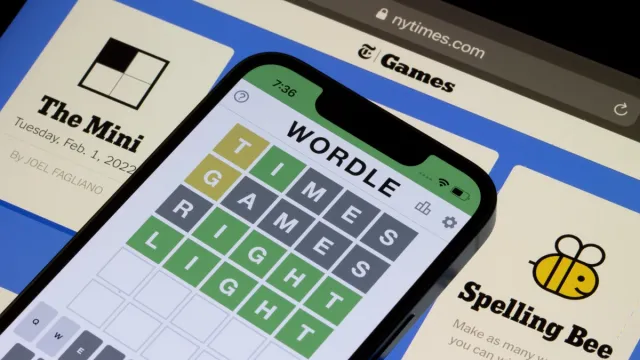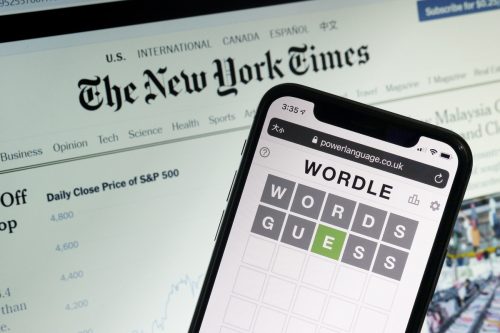How to Play Connections: The NYT’s New Wordle Game Alternative

The first New York Times crossword appeared in its Sunday edition on Feb. 15, 1942. For years, this satisfied the readers’ game cravings. Years later, content moved online with the advent of digital media and print subscriptions subsequently plummeted. Many readers swapped in their papers for access to web platforms, drastically changing the way puzzles are played.
In 2008, the Times introduced Wordplay, its daily crossword blog. And in 2021, Wordle hit the scene. The game went from having a handful of players to hundreds of thousands in just a few months, encouraging the company to make even more puzzle games available to users. Below, we’ll explain how to play Connections—the most recent addition to the list. We’ll also walk you through how to access the game along with a few fun alternatives.
RELATED: 20 Fun Online Games to Play With Friends From Afar.
How to Play Connections
Connections was added to the New York Times Games section at the end of June 2023. The game tagline reads, “Group words that share a common thread.” Once in, you’ll be faced with a 4×4 grid, with each box containing a specific word. Players must group together the words based on a common theme or—you guessed it—connection.
It can be more challenging than you might assume. For instance, what do the words, “full,” “circle,” monty,” and “moon” have in common? Nothing? Think again. Each happens to make a whole lot of sense when preceded by the word “full.” As New York Times puzzle editor Wyna Liu revealed, categories can range from palindromes, homophones, or words that lose or add a letter.
Once you think you’ve identified the “connection,” click the four items that belong together and hit “Submit.” You only have four chances to finish the entire puzzle, so take your time. You’ll need it to identify all four groups scattered around the grid.
What Do the Colors Mean in Connections?
Within the game, each group is organized by four different colors: Yellow, green, blue, and purple. They appear in spectral order to reflect the difficulty assigned to each category.
Yellow is the easiest, or most straightforward category, while green and blue typically revolve around unfamiliar terms or trivia. Purple represents the trickiest category and almost always involves some kind of wordplay.
Another interesting detail about the game: You don’t need to complete the categories in any specific order to move on to the next puzzle. It’s possible to identify the purple group, the hardest category, first and then work your way back towards the easiest.
How Is Connections Different From Wordle?

Though both puzzles fall into the category of “word games,” there are a few notable differences between the two. Wordle is a word guessing game, in which players attempt to guess a mystery word based on past attempts and game feedback. Connections is a word association game, in which players must identify a common theme among a group of words.
You also have fewer opportunities to win Connections. Wordle gives players six chances to guess the word, while Connections only gives you four guesses to sort out the puzzle.
What’s the Point of Playing Connections?
Simply put: It’s fun.
There are some additional benefits to word games, though. Games like Connections and Wordle can also maintain your brain health. These types of puzzles stimulate different parts of the brain, exercising your reasoning, language, problem-solving, and visual perception skills.
Not only that, but working out brain games can also slow down declines in cognitive health. It all boils down to the “use it or lose it” principle: The more you exercise these areas of the brain, the better they perform over time.
There are also a few mental health components. Playing word games—and winning—give users a sense of accomplishment and success. Losing yourself in a game, even if just for a few moments, can also help reduce tension and stress.
Where Can I Play Connections?
Connections is available to play for free on the New York Times website or via its app. Unfortunately, only one puzzle is released per day, so you’ll have to wait 24 hours before you can play again.
RELATED: The 20 Best Games to Play With Your Most Competitive Friends.
Other Wordle Alternatives: Spelling Bee, Letter Boxed, Tiles, and More
If you aren’t interested in Connections, don’t worry—there are plenty of other games available for you to play. The New York Times also offers the following word puzzles:
- Wordle
- Spelling Bee
- Letter Boxed
- Tiles
- Vertex
- Sudoku
There are also plenty of Wordle alternatives outside of the New York Times platform. Some of the most popular include:
- Hello Wordl
- Wrodeo
- Picsey
- Absurdle
- Dordle
- Trordle
Those who are interested in Connections should also know that there are archives available that allow you to play previously published puzzles. Custom creators are available, too, so you can create your own puzzle for friends to solve.
Wrapping Up
That’s it for now, but be sure to check back with us soon for more amazing games. You can also sign up for our newsletter so you don’t miss out on what’s next!